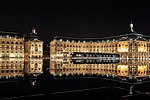Piliers de Tutelle

The Piliers de Tutelle (meaning Pillars of Guardianship in French) was an important Gallo-Roman monument erected in the third century on the approximate location of the southwest corner of the Grand Théâtre of Bordeaux, a city in southwestern France. It was built around the late second century or early third century BC during the Roman period in France, and shares many features with similar pillared porticos and colonnades of the same period in other lands of the Roman Empire. The tall, rectangular monument was composed of twenty-four tall columns topped by an architrave, and enhanced by an arcaded crowning decorated with bas reliefs on forty-four bilateral pillars placed above. The reliefs dpicted young women standing upright (caryatids). It was demolished in early 1677 during the transformation of Trompette Castle into a bastioned citadel by orders of the king of France, Louis XIV, known as the Sun King. Today the Piliers is only known through old engravings and contemporary testimonies of the time.
Excerpt from the Wikipedia article Piliers de Tutelle (License: CC BY-SA 3.0, Authors, Images).Piliers de Tutelle
Place de la Comédie, Bordeaux Triangle d'Or
Geographical coordinates (GPS) Address Nearby Places Show on map
Geographical coordinates (GPS)
| Latitude | Longitude |
|---|---|
| N 44.842777777778 ° | E -0.57444444444444 ° |
Address
Place de la Comédie 5
33000 Bordeaux, Triangle d'Or
Nouvelle-Aquitaine, France
Open on Google Maps







